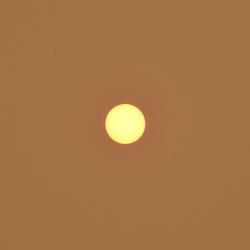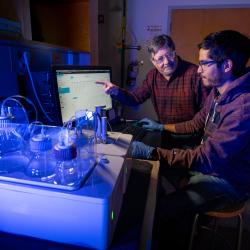Building Fundamental Knowledge to Arm Medical Science
Professor David Fushman studies proteins involved in regulating important cellular processes that are often hijacked by viruses, bacteria and even cancer.
To win a war, you must not only know your enemy, you must know yourself. That is arguably one of the most pervasive messages in the famous 2,500-year-old Chinese treatise on military strategy, “The Art of War.”

Perhaps nowhere is that message more important than in the battle against disease. Whether it’s cancer, infection or Alzheimer’s, the enemy is a disease that exploits the intricate systems the human body depends on to survive. Understanding those systems gives doctors a shot at defeating the diseases that attack them.
Chemistry and Biochemistry Professor David Fushman is working to piece together the puzzle of how one critical system, the ubiquitin signaling system, works to keep cells healthy and functioning properly. To do this, he studies the 3D structure and composition of proteins, and more specifically, the tiny protein at the center of the ubiquitin signaling system called ubiquitin.
Found in all plant and animal cells, ubiquitin can be thought of as a kind of label that attaches to nearly every other protein in a cell. A single ubiquitin molecule, or a chain of ubiquitins, attached to another protein in a specific way may signal that the protein is no longer required, or it is deformed and needs to be destroyed or removed from the cell. Meanwhile, a different ubiquitin chain may signal that a cell’s DNA is damaged and needs to be repaired.
“My lab is focused on trying to understand the structure of these ubiquitin protein tags—how they fold, how they move and interact, and how different ubiquitin tags are being recognized as different signals within the cells,” Fushman said.
Fushman has been teasing apart various aspects of the ubiquitin signaling system since joining the University of Maryland in 2000. His work on ubiquitin systems has resulted in more than 70 research publications and reviews.
He and the members of his lab have developed methods for making ubiquitin chains of any length. Using nuclear magnetic resonance, X-ray crystallography, small-angle scattering and other biophysical tools, they have determined the 3D structures of certain ubiquitin chains consisting of two, three and four ubiquitin molecules.
For some of those chains, they have even been able to determine how the structure of the ubiquitin molecules enables the various receptor molecules they interact with to identify them.
“In addition to striving to understand the molecular events involved in the recognition and processing of ubiquitin signals, our focus is also on finding inhibitors for the cellular pathways that depend on this ubiquitin-signaling system and gaining understanding of how inhibitors work to pave the way for developing drugs and therapies,” Fushman said.
Fushman’s research is becoming increasingly important in the study of disease, because we now know that some bacteria, viruses and cancers can hijack the ubiquitin system. These pathogens can change the ubiquitin “labels” to either convince a cell’s machinery to degrade the proteins involved in a cell’s defenses or to make more of the pathogen’s own protein.
For example, recent reports suggest coronaviruses may degrade a cell’s defenses using the ubiquitin signaling system. In a molecular game of tag, it appears these viruses add a ubiquitin “destroy me” tag to the end of a watchdog protein whose job is to tag viruses for removal. If that is the case, the cell’s own defense mechanisms would destroy the watchdog proteins and not the virus.
It’s not clear exactly how coronaviruses find and tag watchdog proteins, and it may not be the only mechanism the virus uses to confound the ubiquitin system. But it suggests coronaviruses have learned to use our own defense system against us.
“There is no complete picture of how viruses hijack the ubiquitin system and what exactly they do, but it is clear that they use the ubiquitin system for their purpose,” Fushman said. “Understanding how the structure of these ubiquitin tags affects the way they function means we may be able to understand how pathogens hijack the system or we may be able to learn to control and manipulate the ubiquitin system ourselves.”
Armed with a better understanding of this critical system in our own bodies, medical researchers might one day be able to develop new therapeutics to fight the enemies that have learned to turn that system against us—diseases like cancer, Alzheimer’s and Parkinson’s disease and rapidly emerging pathologies like SARS and COVID-19.
Written by Kimbra Cutlip






